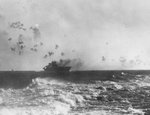oldcrowcv63
Tech Sergeant
Thanks VBF much appreciated. Gotta respect Old Crows knowledge on this subject. he really is encyclopedic on this issue. Doesnt mean we have to agree with everything, and i dont, but I still have great respect for the man and the knowledge he has.
Thanks Pars. I started studying the Midway battle after reading Lord's Incredible Victory before joining the USN. For some reason, it really grabbed my interest and I couldn't read enough to satisfy my curiosity. (like it hasn't fascinated anyone else?) Along the way, I started asking questions the written texts didn't answer or provided answers that just had to be wrong. As an aside, the more I read about Fletcher, the more interested I became in him. The official, historical and popular accounts seemed to be missing some fundamental elements of the story of Midway and of Fletcher as a leader. The more I read the more questions I had. Lundstrom's book was a revelation, answering some questions, confirming some suspicions, while raising some new questions. There's more to the story but let's just say, the Midway battle has been a long held interest bordering on obsession.
I wouldn't expect you to agree with everything which is why I do my best to provide at least some semblance of justification, as best I can and because I believe, like me, you want the straight scoop which ever way it goes. I hope you know the respect is certainly reciprocated. I've learned something from just about every interaction on this forum including from you Pars and you VB.
The Fletcher story is complex and my brief rant about ego is far too simplistic, there are certainly other black shoe admirals who weren't vilified to the same extent. His decline evidently began well before the Coral Sea Battle when King regarded him as far too cautious in his abortive attempt to relieve Wake island. Later, King became more convinced of this when he wasn't more proactive in taking the fight to the enemy in the Coral Sea area during the winter of 42. King's feeling was tempered somewhat as a result of the raid made by he and Wilson Brown on IJN fleet elements Lae and Salamua in New Guinea. King blamed him for the loss of the Lexington at Coral Sea and joined the chorus of those aviators who objected to operating their carriers as closely coordinated units for combined CAP defense (similar to IJN doctrine) USN aviation leadership wanted to separate the Flight decks by several 10's of miles to decrease their probability of being detected. (At Midway a combination of the two philosophies were employed. The Fletcher-Fitch tactic employed at Coral Sea didn't work all that well and Lexington was fatally wounded. At Midway the same tactical deployment might have saved Yorktown its own ultimately fatal torpedo wounds. (Yorktown only became submarine bait after the Kates did their deadly and efficient work.) During the Guadalcanal invasion, so many complaints were lodged by the USMC general (Vandergrift) and USN Admiral (Turner) running the invasion, that, despite his largely effective performance at Eastern Solomons, King had had enough. The dissection of these events is a laborious task but worth the read. I recommend Lundstrom's Black Shoe Carrier Admiral and Layton's "And I was there..." I think it was for Turner that Nimitz made the famous quote Morrison cites, "Every dog deserves two bites." You get a vivid picture of Turner in Lundstrom's, Layton's, Frank's and Hornfischer's books and I think even Morrison has some things to say about him.
Pars, anyone interested in carrier aviation has to at least tip his hat to Polmar. Every book on Midway I've read has added some dimension to the story and I appreciate all the contributions. Even Tuleja's.
Last edited:

